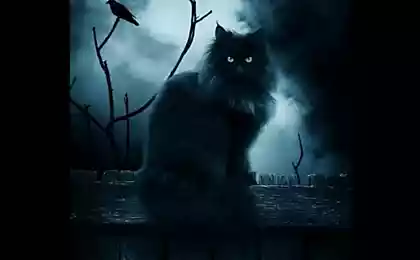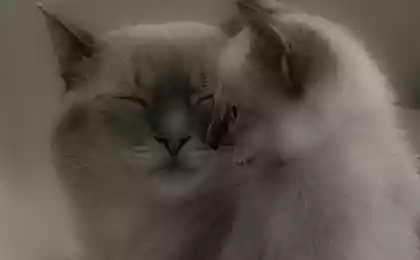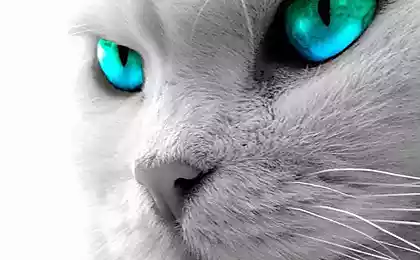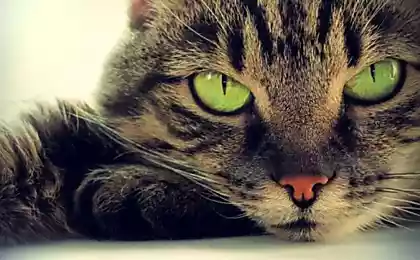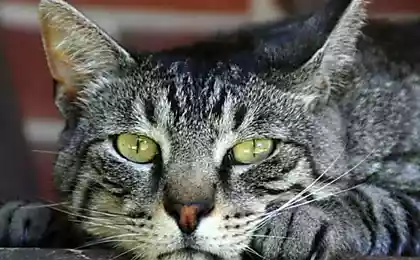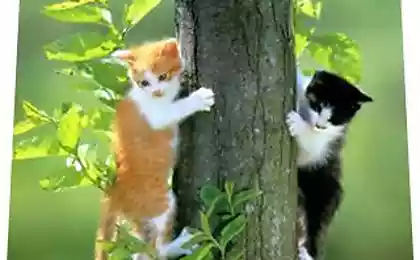1063
As cats taken over the world!
Cats can be very gentle, but at the innocuous exterior hides an ancient predator, ready to kill not razdumyvaya.Ryadom us live creatures, ignoring thousands of years of evolution, but we continue to love them without even thinking about it.

The immediate ancestor of the four-legged inhabitants of our apartment was a wild cat Felis silvestris lybica (F. s. Lybica), who now lives in North Africa. The American geneticist Carlos Driscoll and his colleagues in 2007 found that about 10 000 years ago, at least five females of F. s. lybica were taken from the wild in the house and they became the mother of all modern domestic cats. Between the steppe cat and present pets many genetic differences, but nevertheless, when crossed in animals born kittens. Unplanned novels often occur so quickly view F. s. lybica may disappear altogether, and blame the cat will be locals.
Dogs, too, were once wolves, but they quickly adopted the new rules of the game, and became man. In contrast, cats have retained independence and in the warmth and safety of urban dwellings behave as if living in the wilderness, where you have a long time to hunt for prey, and at every step of waiting for the same hungry predators. Many of the strange behavior of cats - adaptive mechanisms by which these creatures survive without a man.

Water and blood
For example, domestic cats rarely drink water that the owners are left near the saucer, where the food is placed. Cat lapping tea and stewed dishes forgotten on the table, catching drops from the tap, and even trying to water from the toilet, stubbornly ignoring the one that was prepared especially for her. Harmful and stubborn? Not at all, it is a sensible precaution, which does not give the cat to pick up a deadly infection. Over millions of years in the wild food for animals cats were killed by it or someone else. The cat could not know how long it is here found the carcass and have not got there it bred germs in the nearest pond. Even if the animal itself has just killed the victim, fresh blood does not improve the taste of water. Therefore predators never drank water in the place where the dinner.
Cats in general a little drink. Over millions of years of evolution in the desert, where they lived F. s. lybica, the body of the cat learned to economize precious milliliters. Kidneys recovered almost all the water from the urine, making it a very concentrated (so the cat litter is always a strong smell). In an extreme case, the cat can quench their thirst with sea water, because their renal tubules remove salt from water (for people out of the sea water is not suitable because their kidneys can not cope with large amounts of salt excretion).
To save water, feline little sweat - they have few sweat glands, therefore, even in the heat of the water is not running out of the body. But cats are easily overheated in the sun.
A few sweat glands preserved in these animals on paws, but significantly lower their body temperature can not help. Animals use the sweat and the surroundings odorous glands to mark territory. The last wild cat left his scent on all surfaces to which could get. Today, the beasts have to settle for wallpaper and sofa legs. Cats do not sharpen claws, they represent its zone of influence, and themselves choose which subjects to leave the label. Therefore, most specifically purchased by the owners of devices for "sharpening" remain intact. Even those animals that have claws clipped, will be attracted to a favorite place. By the way, wild cats without claws could not survive the week - try to survive on a desert island, where you have all the fingers without the upper phalanx.
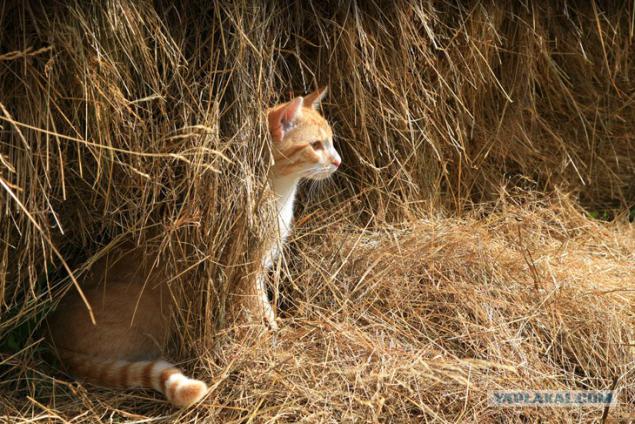
Meat and sugar
Another feature, which is preserved in cats since their last self - is a flurry of activity at the wrong (according to man) time. The peak activity of the animals at dusk falls, that is early evening and the morning before dawn. It was at that time the ancient hunting cats. It is not known why they adhered to this schedule, but is likely to have been several reasons. First, run day in the desert too hot, and secondly, most of the large predators are active during the day or at night. Escaping from hiding in the shadows, the cat used the minimum of light, which is in the twilight, and at the same time avoiding unwanted encounters. Although the apartment is growing food in the refrigerator, and the most terrible predator - a small child, the biological clock cats still awaken them when the owners most want to sleep.
Looks harmless cats only deceiving the people: the other inhabitants of the towns and villages are rightly considered the main enemies of these animals. In 2013, American zoologist at the Smithsonian Institute of Biodiversity and the United States Fish and Wildlife Service estimated that the stray and domestic cats together every year, killing 1, 4 to 3, 7 billion birds and 6, 9 to 20, 7 billion mammals: rats, mice, shrews, and even protein rabbits. According to scientists, all during coexistence with man "cute kitties" destroyed 33 species of living beings. These animals are so "incarcerated" under the predation that have lost the ability to feel the sweet taste - the meat a little sugar, so to distinguish them food for cats optional.

Rodents and scum
Preserved wild nature and behavior of the cat does not like other animals, domesticated by man. Unlike dogs or cats cows radically improve the lives of the owners. It is unlikely that the ancient people allow themselves the luxury of feeding a wayward beast, without which it is possible to do. And it seems people do not really tame these animals specifically. Carlos Driscoll said the cat entered the house through ... mice and debris.
Mice were among the first animals threw a wild life and have mastered the human cellars on the territory of the Fertile Crescent - the Middle East region, the birthplace of many civilizations. Scientists have found the remains of the house mouse Mus musculus domesticus in Israel's grain storage facilities, constructed about 10 000 years ago. Cats moved after the rodents and, according to Driscoll, found in human settlements not only escaped the food, but also an attractive trash heap. As a result, those animals are not afraid of strange bipeds, firmly entrenched on the ancient dumps.
Users, for their part, did not object to the neighborhood with a very scary - and even quite cute - animals. Cute appearance of these animals attracted Homo sapiens (Homo sapiens especially female). So once a resident of the Middle East took the kitten to her charming, and since then the history of people and cats became the joint.
Having found the house, the cat is still preying on rodents, but their assistance was optional. Of course, people have tried to remain with kittens from the best rat-catchers, but as sure Driscoll, especially selection no one did. Besides cats always went out of the house on his own business, so save the progeny some line was difficult.
Not so was the case with dogs - people purposefully crossbred animals to bring hunters, watchmen or shepherds. Due to the strict selection the former Wolves lost the aggression and freedom, and to their own cats have not changed, except that the intestines have become longer to digest not only meat, but also delicious dregs.
***
But what is the evolution of cats over? Most likely, the further direction of selection and breeding the most peaceful and compliant do their work, and domestic cats hunting completely forget the past. But one night, when the moon rises, even the most pedigreed cat remember who she is. And - by Rudyard Kipling - climb up on roofs and wet wild wild wild zamashet its tail.

EXPANSION
How exciting world of domestic cats
1 Around 10 000 years ago, cats were first to live close to the people of the Fertile Crescent.
2 Finally, the cats were domesticated in Egypt around 3,600 years ago and 2,300 years ago, the Egyptians ban the export of the sacred beasts of the country.
3 However, about 2300 years ago, cats on ships come to Greece, and later also by the sea spread over the Roman state.
4 Over the next 500 years, cats spread across the whole of Europe.
5 In the British Isles cat mysteriously came before the Romans got there.
6 - 7 The Great Silk Road the animals get into China and India, where isolation from the other cats there are new breed Siamese,
Korat and Burmese.
8 Presumably the cats get to America at the turn of the XV-XVI centuries on the ships of Columbus.
9 animals in Australia is likely to bring in the XVII century.
Photo: SHUTTERSTOCK (X7)
Took here: www.vokrugsveta.ru/article/200637/
The end!!!

Source:

The immediate ancestor of the four-legged inhabitants of our apartment was a wild cat Felis silvestris lybica (F. s. Lybica), who now lives in North Africa. The American geneticist Carlos Driscoll and his colleagues in 2007 found that about 10 000 years ago, at least five females of F. s. lybica were taken from the wild in the house and they became the mother of all modern domestic cats. Between the steppe cat and present pets many genetic differences, but nevertheless, when crossed in animals born kittens. Unplanned novels often occur so quickly view F. s. lybica may disappear altogether, and blame the cat will be locals.
Dogs, too, were once wolves, but they quickly adopted the new rules of the game, and became man. In contrast, cats have retained independence and in the warmth and safety of urban dwellings behave as if living in the wilderness, where you have a long time to hunt for prey, and at every step of waiting for the same hungry predators. Many of the strange behavior of cats - adaptive mechanisms by which these creatures survive without a man.

Water and blood
For example, domestic cats rarely drink water that the owners are left near the saucer, where the food is placed. Cat lapping tea and stewed dishes forgotten on the table, catching drops from the tap, and even trying to water from the toilet, stubbornly ignoring the one that was prepared especially for her. Harmful and stubborn? Not at all, it is a sensible precaution, which does not give the cat to pick up a deadly infection. Over millions of years in the wild food for animals cats were killed by it or someone else. The cat could not know how long it is here found the carcass and have not got there it bred germs in the nearest pond. Even if the animal itself has just killed the victim, fresh blood does not improve the taste of water. Therefore predators never drank water in the place where the dinner.
Cats in general a little drink. Over millions of years of evolution in the desert, where they lived F. s. lybica, the body of the cat learned to economize precious milliliters. Kidneys recovered almost all the water from the urine, making it a very concentrated (so the cat litter is always a strong smell). In an extreme case, the cat can quench their thirst with sea water, because their renal tubules remove salt from water (for people out of the sea water is not suitable because their kidneys can not cope with large amounts of salt excretion).
To save water, feline little sweat - they have few sweat glands, therefore, even in the heat of the water is not running out of the body. But cats are easily overheated in the sun.
A few sweat glands preserved in these animals on paws, but significantly lower their body temperature can not help. Animals use the sweat and the surroundings odorous glands to mark territory. The last wild cat left his scent on all surfaces to which could get. Today, the beasts have to settle for wallpaper and sofa legs. Cats do not sharpen claws, they represent its zone of influence, and themselves choose which subjects to leave the label. Therefore, most specifically purchased by the owners of devices for "sharpening" remain intact. Even those animals that have claws clipped, will be attracted to a favorite place. By the way, wild cats without claws could not survive the week - try to survive on a desert island, where you have all the fingers without the upper phalanx.

Meat and sugar
Another feature, which is preserved in cats since their last self - is a flurry of activity at the wrong (according to man) time. The peak activity of the animals at dusk falls, that is early evening and the morning before dawn. It was at that time the ancient hunting cats. It is not known why they adhered to this schedule, but is likely to have been several reasons. First, run day in the desert too hot, and secondly, most of the large predators are active during the day or at night. Escaping from hiding in the shadows, the cat used the minimum of light, which is in the twilight, and at the same time avoiding unwanted encounters. Although the apartment is growing food in the refrigerator, and the most terrible predator - a small child, the biological clock cats still awaken them when the owners most want to sleep.
Looks harmless cats only deceiving the people: the other inhabitants of the towns and villages are rightly considered the main enemies of these animals. In 2013, American zoologist at the Smithsonian Institute of Biodiversity and the United States Fish and Wildlife Service estimated that the stray and domestic cats together every year, killing 1, 4 to 3, 7 billion birds and 6, 9 to 20, 7 billion mammals: rats, mice, shrews, and even protein rabbits. According to scientists, all during coexistence with man "cute kitties" destroyed 33 species of living beings. These animals are so "incarcerated" under the predation that have lost the ability to feel the sweet taste - the meat a little sugar, so to distinguish them food for cats optional.

Rodents and scum
Preserved wild nature and behavior of the cat does not like other animals, domesticated by man. Unlike dogs or cats cows radically improve the lives of the owners. It is unlikely that the ancient people allow themselves the luxury of feeding a wayward beast, without which it is possible to do. And it seems people do not really tame these animals specifically. Carlos Driscoll said the cat entered the house through ... mice and debris.
Mice were among the first animals threw a wild life and have mastered the human cellars on the territory of the Fertile Crescent - the Middle East region, the birthplace of many civilizations. Scientists have found the remains of the house mouse Mus musculus domesticus in Israel's grain storage facilities, constructed about 10 000 years ago. Cats moved after the rodents and, according to Driscoll, found in human settlements not only escaped the food, but also an attractive trash heap. As a result, those animals are not afraid of strange bipeds, firmly entrenched on the ancient dumps.
Users, for their part, did not object to the neighborhood with a very scary - and even quite cute - animals. Cute appearance of these animals attracted Homo sapiens (Homo sapiens especially female). So once a resident of the Middle East took the kitten to her charming, and since then the history of people and cats became the joint.
Having found the house, the cat is still preying on rodents, but their assistance was optional. Of course, people have tried to remain with kittens from the best rat-catchers, but as sure Driscoll, especially selection no one did. Besides cats always went out of the house on his own business, so save the progeny some line was difficult.
Not so was the case with dogs - people purposefully crossbred animals to bring hunters, watchmen or shepherds. Due to the strict selection the former Wolves lost the aggression and freedom, and to their own cats have not changed, except that the intestines have become longer to digest not only meat, but also delicious dregs.
***
But what is the evolution of cats over? Most likely, the further direction of selection and breeding the most peaceful and compliant do their work, and domestic cats hunting completely forget the past. But one night, when the moon rises, even the most pedigreed cat remember who she is. And - by Rudyard Kipling - climb up on roofs and wet wild wild wild zamashet its tail.

EXPANSION
How exciting world of domestic cats
1 Around 10 000 years ago, cats were first to live close to the people of the Fertile Crescent.
2 Finally, the cats were domesticated in Egypt around 3,600 years ago and 2,300 years ago, the Egyptians ban the export of the sacred beasts of the country.
3 However, about 2300 years ago, cats on ships come to Greece, and later also by the sea spread over the Roman state.
4 Over the next 500 years, cats spread across the whole of Europe.
5 In the British Isles cat mysteriously came before the Romans got there.
6 - 7 The Great Silk Road the animals get into China and India, where isolation from the other cats there are new breed Siamese,
Korat and Burmese.
8 Presumably the cats get to America at the turn of the XV-XVI centuries on the ships of Columbus.
9 animals in Australia is likely to bring in the XVII century.
Photo: SHUTTERSTOCK (X7)
Took here: www.vokrugsveta.ru/article/200637/
The end!!!

Source:
